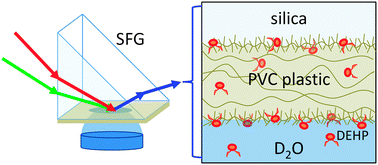Interfacial molecular restructuring of plasticized polymers in water†
Abstract
Upon water contact, phthalate-plasticized poly(vinyl chloride) (PVC) surfaces are highly unstable because the plasticizer molecules are not covalently bound to the polymer network. As a result, it is difficult to predict how the surface polymer chains and plasticizers may interact with water without directly probing the plastic/water interface in situ. We successfully studied the molecular surface restructuring of 10 wt% and 25 wt% bis 2-ethylhexyl phthalate (DEHP)-plasticized and pure PVC films (deposited on solid substrates) in situ due to water contact using sum frequency generation (SFG) vibrational spectroscopy. SFG spectral signals from both the top and the bottom of the plastic film were obtained simultaneously, so a thin-film model spectral analysis was applied to separately identify the molecular changes of plastics at the surface and the plastic/substrate interface in water. It was found that in water both the structures of the plastic surface and the buried plastic/substrate interface changed. After removing the samples from the water and exposing them to air again, the surface structures did not completely recover. Further SFG experiments confirmed that small amounts of DEHP were transferred into the water. The leached DEHP molecules could reorder and permanently transfer to new surfaces through water contact. Our studies indicate that small amounts of phthalates can transfer from surface to surface through water contact in an overall scope of minutes. This study yields vital new information on the molecular surface structures of DEHP plasticized PVC in water, and the transfer behaviors and environmental fate of plasticizers in polymers.


 Please wait while we load your content...
Please wait while we load your content...